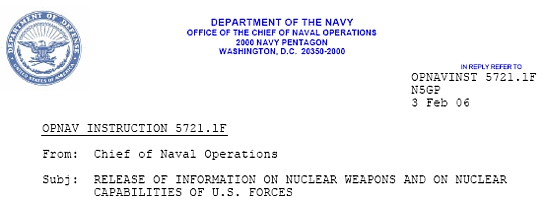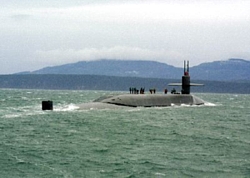Nuclear Brief February 8, 2006
The Neither Confirm Nor Deny Policy

Although the U.S. government in 1992 announced to the
world that it had removed all tactical nuclear weapons from its surface
ships, attack submarines, and naval aircraft, the Navy has issued a new
instruction that orders navy personnel not to tell anyone.
The new instruction, "Release
of Information on Nuclear Weapons and on Nuclear Capabilities of U.S.
Forces," was issued by the office of Chief of Naval
Operations on February 3, 2006. It reaffirms the so-called Neither
Confirm Nor Deny Policy (NCND) by directing that:
"Military members and civilian employees of the
Department of the Navy shall not reveal, purport to reveal, or cause
to be revealed any information, rumor, or speculation with respect
to the presence or absence of nuclear weapons or components on board
any specific ship, station or aircraft, either on their own
initiative or in response, direct or indirect, to any inquiry."
At the same time the instruction orders navy personnel
not to tell anyone that there are no nuclear weapons onboard U.S.
warships, the instruction -- which is a public document available on the
Navy's web site -- also confirms that it is U.S. policy not to deploy
nuclear weapons on the warships:
"It is general U.S. policy not to deploy nuclear
weapons aboard surface ships, naval aircraft, attack submarines, or
guided missile submarines."
Guided Missile Submarines
|
First of
Four SSGNs |
 |
The USS Ohio (SSGN-726) arrives in Puget
Sound, Washington, in January 2006 following conversion from
Trident ballistic missile submarine to non-nuclear guided
missile submarine for Tomahawk cruise missiles and special
forces.
Credit: U.S. Navy |
The instruction also reveals that four guided missiles
submarines (SSGN) currently under
conversion from ballistic missiles submarines
(SSBN) to carry Tomahawk cruise missiles and special forces will not be
carrying nuclear weapon:
"For these four ships, the submarine-launched
ballistic missile capability will be replaced with a conventionally
armed, guided cruise missile capability similar to that resident on
attack submarines." It is U.S. policy, the instruction states, "not
to deploy nuclear weapons aboard…guided missile submarines."
The Tomahawk missile also exists in a nuclear version
and ever since the Navy decided to convert the four SSBNs to SSGNs it
has not been officially stated that the ships will only carry
conventional. The new instruction specifically states that the Tomahawks
carried on the boats will be conventional.
In fact, the whole purpose of issuing
OPNAVINST 5721.1F appears to be to incorporate the SSGNs into the
NCND guidance. The
previous version of the instruction from 1993 does not mention
SSGNs.
Background
For nearly 50 years, the United States has maintained
a policy of neither confirming nor denying the presented or absence of
its nuclear weapons anywhere. Other nuclear powers have operated a
similar policy, but the U.S. case is much better documented as a result
of worldwide deployment of nuclear weapons during the Cold War and
because of greater access to government information.
Officially, the policy was justified as a way to
strengthen deterrence and protect individual ships and bases against
sabotage. But the NCND's real use was in countless diplomatic and public
affairs battles around the world to evade political and public
opposition to nuclear weapons in allied and adversary countries.
Four allied countries the NCND presented a particular
problem. Many of them had public policies or legislation in place that
prohibited the presence of nuclear weapons on their territories, but
maintaining close political and military ties with the United States was
also a high priority. The United States insisted that the NCND policy
was in effect when U.S. warships visited, but accepting the NCND policy
also meant that the host government inevitably had to accept that
nuclear weapons would come in once in a while. The governments could not
admit this reality in public, however, and instead decided with various
degree of luck and diplomatic elegance to "turn a blind eye" to the
violation of their nuclear policy.
For a chronology of how the NCND policy was applied --
and what it meant -- read the report "The
Neither Confirm Nor Deny Policy: Nuclear Diplomacy At Work."
|

